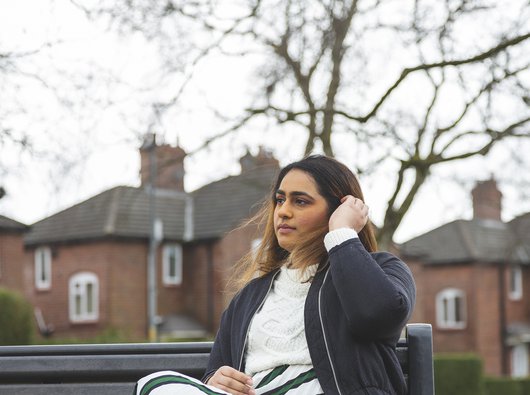Active treatment for acute lymphoblastic leukaemia (ALL)
Your treatment will be divided into three phases, or ‘blocks’. Your hospital team will explain which drugs you’ll have and when during each phase.
Chemotherapy
Chemotherapy is the main active treatment for ALL. You’ll be offered a combination of chemotherapy drugs as set down in your treatment plan (your healthcare team may call this a protocol or regimen).
Most chemotherapy for ALL will be injected into the bloodstream through a vein (known as intravenous infusion).
Drugs will usually be given directly into a tube, known as a central line, which is inserted into a large blood vessel. This line is kept in over the whole period that you have treatment, so there’s no need for repeated injections.
There are different types of central line. These include:
- a PICC line or Peripherally Inserted Central Catheter − a central line that’s put into your arm (the most commonly used central line)
- a Hickman® line − a central line that can be put under the skin in your chest.
Information for young adults
For young adults with leukaemia, lymphoma or any blood cancer type. Your guide to treatment, side effects, coping with emotions, friends and work or study.

Phase 1: remission induction
The aim of this first phase of treatment is to get you into remission (also called complete remission or CR), where there’s no sign of leukaemia. This involves using several chemotherapy drugs in combination.
The goal is to clear the leukaemia cells completely from your blood and bone marrow. This works for about nine out of ten people (90%).
The length of this treatment stage depends on your individual situation, but usually lasts between four weeks and two months.
Because there’s a risk of infection or bleeding, you’re likely to spend all, or most, of this stage in hospital, with your healthcare team close by.
Remission induction for Philadelphia positive ALL
If you have Philadelphia positive ALL, your treatment will be different. Doctors use drugs called tyrosine kinase inhibitors (or TKIs) to treat it. These drugs target the abnormal protein, tyrosine kinase, which is produced by the leukaemia cells.
When used alongside standard chemotherapy, TKIs can significantly increase the chance of a cure for people with Philadelphia positive ALL.
The TKI that most people with Philadelphia positive ALL will be given is called imatinib.
Intrathecal chemotherapy
Around this time, you may also have what’s called intrathecal chemotherapy to give extra protection to your brain and spinal cord.
Chemotherapy drugs will be injected into the cerebrospinal fluid (CSF) that surrounds your spine to try and prevent leukaemia cells from entering the fluid.
Testing for remission
When your initial chemotherapy is finished, doctors will look at samples of your blood and bone marrow under a microscope. If they can’t see any leukaemia cells, this means you’re in remission (CR).
Minimal residual disease tests
You may also have a minimal residual disease test (MRD) to check how complete your remission is.
When your doctors look at blood cells through a microscope, the lowest level of leukaemia they can detect is if around one in every 20 cells is a leukaemia cell.
The MRD test is much more sensitive and can detect leukaemia cells at levels as low as one leukaemia cell in 100,000 cells. This gives your hospital team more accurate information which can help with planning the next phase of treatment.

Worried about anything or have questions?
If you need someone to talk to, please don't hesitate to contact our Support Service by phone or email.
Phase 2: consolidation
This phase is sometimes called post-induction or post-remission therapy.
It’s usual for some leukaemia cells to remain after your initial chemotherapy, even if doctors can’t see any under the microscope. So when the remission induction phase is finished, you’ll have more chemotherapy to clear any leukaemia cells that might remain in your blood and bone marrow.
This stage usually lasts for several months. It involves several rounds (known as blocks) of intensive therapy, which are similar to the treatment you get at the remission induction stage.
You might be able to have some of this treatment as an outpatient, which means you won’t always have to stay in hospital overnight. But you should be prepared to spend quite a bit of time in hospital.
Stem cell transplant
Some people may be offered a stem cell transplant (also called a bone marrow transplant) during the consolidation phase.
Transplants can make you feel very unwell and can cause complications, so doctors look at a number of things before offering you a transplant. This includes your age and general health, and how well the first phase of your treatment worked.
A transplant aims to give you healthy stem cells, which then produce normal blood cells. There are two types of stem cell transplant:
- allogeneic or allograft – this uses stem cells from another person (a donor)
- autologous or autograft – this uses your own stem cells but is rarely used for ALL.
If you have a stem cell transplant, you will not need the next phase of treatment (maintenance) but will have careful follow-up once you have left hospital.
For more information on stem cell transplants, download or order our booklet Blood stem cell and bone marrow transplants: the seven steps.
The African Caribbean Leukaemia Trust (ACLT) are a charity dedicated to getting more donors on the stem cell register. They also support people and families before and after a donor stem cell transplant.
Phase 3: maintenance
Maintenance therapy aims to prevent the cancer coming back (relapse) and usually involves low doses of chemotherapy and steroids. The maintenance phase is important because without it, there’s a higher chance that the ALL could come back, even if you seem to be in full remission.
We don’t know why this happens, but we do know that having maintenance therapy gives much better results in the long term.
This stage usually takes about two years. Unless you get an infection or have a relapse, you shouldn’t need to stay in hospital and most people on maintenance therapy can start getting back to normal, including going back to work or college.
You will still be at risk of infection at this time, so if you have any symptoms of infection, tell your healthcare team straight away so they can give you the treatment you need.
Although you may feel relieved that the more intensive stages of your treatment are over, you may also feel concerned about seeing your healthcare team less often. If you are worried, talk to your Clinical Nurse Specialist (CNS). They can refer you for counselling if you would like more support.
Find out more about managing your risk of infection.

Connect with others affected by blood cancer
Join our Online Community Forum and connect with people who can understand
